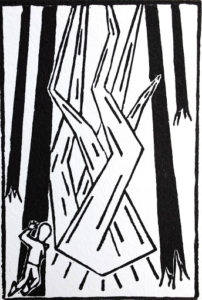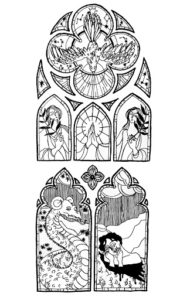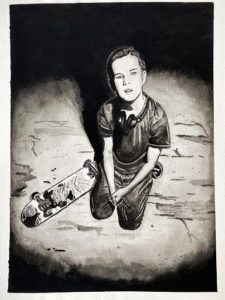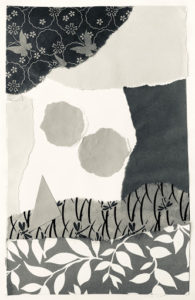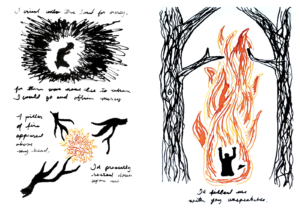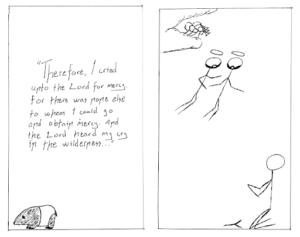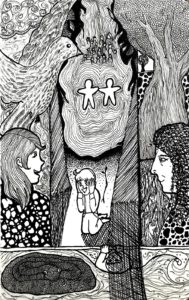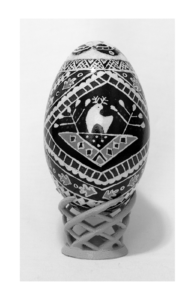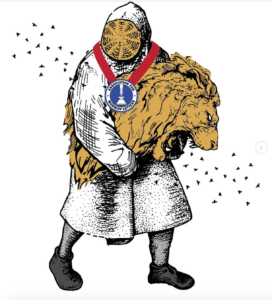 A preview of HIVE ZINE-008 by the ARCH-HIVE collective and the zine contributors. The first five issues of the HIVE ZINE were recently awarded a 2019 Special Award in Literature and Art from the Association for Mormon Letters.
A preview of HIVE ZINE-008 by the ARCH-HIVE collective and the zine contributors. The first five issues of the HIVE ZINE were recently awarded a 2019 Special Award in Literature and Art from the Association for Mormon Letters.
A Brief Note on HIVE ZINE from the ARCH-HIVE
HIVE ZINE is a collaborative zine created by members of the ARCH-HIVE network. Like other zines (short for “magazine”), HIVE ZINEs are short DIY publications focused on a narrow topic—in our case, on the lived experience of Mormonism. Zines have a low barrier to entry to create or purchase, and they are an accessible form of expression & distribution of ideas. The goal of HIVE ZINE is to depict many perspectives & experiences with Mormonism through engaging, accessible art. We are interested in partnering with many collaborators as much as we are interested in sharing with many readers. In a traditionally top-down church culture, we believe a bit of grassroots DIY will do us good.
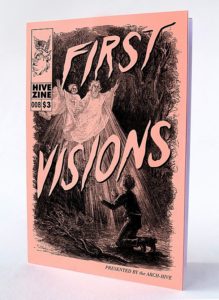 Priscilla Hoarse d’Ivorce, curator of HIVE ZINE-008
Priscilla Hoarse d’Ivorce, curator of HIVE ZINE-008
Working with these artists was a truly incredible experience. When I first started organizing a collaborative First Vision zine, I was expecting a lot of variations on the classic depiction we see in official Church art—maybe from a different view than normal or a bit stylized, but nothing too wild. I was surprised and delighted to find that I was just lacking imagination compared to the contributors to this project. The variety of ways they approached the same subject—from choosing an unusual medium (an egg) to placing it in a modern setting—were so exciting to see and helped me gain a new appreciation for an event I had been taking for granted. I feel incredibly lucky to be associated with this project, and hope it will inspire others to reconsider and perhaps even reimagine the First Vision.
Order a copy of HIVE ZINE-008 here!
I am a boring lawyer by training. I communicate messages through words and rhetoric, usually in an adversarial setting. But I’ve always been envious of visual artists who can communicate deeper, and more meaningful messages, often without words. So I decided to try my hand at communicating some of my feelings about the First Vision through a medium that was completely foreign to me; a linocut print. One aspect of the First Vision I thought I could convey was how scared young Joseph must have been when he saw a “pillar of fire” descending from the sky. I know it would freak me out. To do that, I represented him hiding behind a tree. I’ve never seen a representation of the First Vision with a component like that, and it was an easy way for an untrained artist like me to communicate that aspect of the event. The whole process was tedious, but also refreshing.
As Mormonism nears its 200th birthday, I’ve thought a lot about our relative nearness to its origins, compared to the early Christian church more than two millennia ago. The recency of Joseph Smith’s first vision means we have the benefit of dozens of contemporary records and first-hand sources connected to the events of the Restoration, while biographical facts about Jesus and the Apostles are so scant that the gospels disagree on such foundational details as the identities of the 12 disciples, for example.
Given that relative lack of antiquity, I wanted to explore what Mormonism might look like if it had had two millennia to steep in its mythology and develop the kind of patina of tradition and legend that grew up around the Roman Catholic church through the centuries. My piece is intended to be a look at an imagined timeline where stained glass is used to illustrate the narrative of the Restoration to a largely illiterate medieval populace. The representation of Josephine‘s struggle against Satan in the grove is melded with one of my favorite Catholic saints, Margaret of Antioch, who had a similar encounter with Satan. According to the legend, Satan took the form of a dragon and swallowed her, before she miraculously burst out of the serpent’s side and into the light, much as Joseph Smith burst into the dawnlight of the Restoration.
As for my decision to represent all the characters as women, there were several reasons, but the most honest one is also the most mundane: it’s simply easier for me to draw women than men.
Inspiration for my piece came while hanging out with my son, who is about to turn 14. I was contemplating how I could approach the first vision for this project and realized that Joseph was the same age as my son at the time. It had never occurred to me how young Joseph really was until that moment. I think the traditional depictions make him seem a little older. Or maybe the olden-times clothes just add a sense of maturity. But as I observe my son skateboarding, listening to music and playing video games, it becomes more clear how much of a boy Joseph really was. I decided to do a modern reimagination of the first vision to give others a chance to see Joseph through this lense. Naturally, I used my son as a model.
Watercolor seemed like the right choice for this piece. I started experimenting with watercolors while I was in medical school as an outlet to relieve stress and anxiety. It mostly worked!
This was actually my second attempt—I was originally trying to design a cross stitch pattern (reproducible art for your home!) but found myself just a teensy bit uncomfortable representing the beloved divine as a weirdly angular, shambling horror (also, the imagery was getting lost in the attempt to make a workable pattern). So, lacking the ability to draw at all, I decided abstract paper art was probably my best option. Deciding how to represent the pillar of light was more challenging than I initially expected. I first tried an angular pillar with two smaller rectangles in it to represent Heavenly Father and Christ, but the contrast with the torn edges of the natural setting felt wrong. I felt that representing them as circles (a shape without an end) with torn edges made more sense and highlighted their connection with the trees and the earth. Joseph, on the other hand, is angular and has sharp edges—not only because a triangle looks like kneeling to pray, but also because he’s only just beginning the refining process.
As I reread the various first vision accounts, I decided that for my contribution I wanted to focus on two things: the narrative arc of deliverance from darkness and confusion, and the image of the pillar of fire that drives away the darkness. The pillar of fire is an image that Joseph seems to initially use in his earliest account to describe his experience before apparently crossing it out and replacing it with “pillar of light,” (he later returns to using it in one of his other accounts). Scripturally, the pillar of flame represents God’s presence, and Joseph’s use of it evokes Moses as well as Lehi, but Joseph makes it his own by having it appear not on an ancient desert rock, but in the woods of his own home in Western New York, which is also my home. As a nod to Joseph’s day-to-day life, and as a challenge to myself, I chose to do my contribution with a goose quill dipped in ink—the type of pen that Joseph himself and his scribes would have likely used to compose his earliest account of his vision. I made a few initial sketches with pencil and with a modern fountain pen with a steel nib, but using the quill was a very different experience. Joseph wrote about how hard it was for him to put spiritual things into written language, but the experience of learning how to cut a goose quill into a nib and then using it to write and draw gave me an appreciation for how laborious it must have been for Joseph to put things in writing, both physically as well as intellectually.
I had loads of half-baked ideas for what I wanted to focus on (lightsabers! Ents! Tapirs!), but settled on stick figures in part because of artistic necessity and in part because I liked the simplicity and the way it invoked xkcd (a popular webcomic), which brought some levity to the depiction. I also like the way that each stick figure functions largely as an empty canvas for the viewer to insert themselves into the piece, specifically as Joseph (God the Father and Jesus have beards and halos and the heavenly host have wings, which differentiate them some).
I also like the way the stick figures seem to highlight the wildness and absurdity of the First Vision, which I have a tendency to downplay and recite as if it was a mundane, everyday occurrence. I wanted to highlight the unbelievability and fantastic nature of the event, but in a sort of stripped down, understated way? Oh, and I threw a little folk magic tease in because I love that element of early Mormonism.
In my high school days I enjoyed doodling to fill up an entire page, which I learned is a style often used by outsider artists and is often called horror vacui (fear of the vacuum/empty space). My fourth grade art teacher was the one who told me I could draw a few clumps of grass to stand in for an entire field, and I now take a perverse pleasure in drawing every feather, scale, and leaf. One of our Discord members, Tod Robbins, posted a calendar cover by Kent Maxwell in a similar style and I felt like this style I’m drawn to could be something other people would be interested in.
I attended Anthony Sweat’s lecture on first vision imagery, which brought the pillar of fire to my attention. He also includes the host of heaven in his painting. Contemplating the other elements, I felt like the Holy Ghost would be air, Mother in heaven would be earth, and water the devil. I’d recently been admiring the border art on illuminated manuscripts and etchings, which inspired my composition. Looking back on Joseph Smith’s vision narratives, I wanted to emphasize the joy he felt–and what better way than with anime star-eyes?
Growing up, I always felt I was lacking in artistic ability. I think I didn’t understand that art doesn’t have to come from formal training, but can come from the heart’s inspiration.
My father’s family heritage in part comes from Romania. I have always felt a deep connection with my family’s homeland and have always felt myself being called back there. Surprisingly, it was my mother-in-law that first introduced me to pysanky! I felt inspiration spark as soon as I began learning. I learned about the symbols and more about the history, and I felt genuine joy as I created.
As soon as I heard the prompt for this zine, I thought that pysanky would work well with depicting the First Vision. My Romanian great-grandfather believed that our connection with divinity could be better fostered in the woods than in any man-made structure!
I used symbols from pre-christianity Europe to depict the First Vision. You can see a young stag representing the young prophet, ladder symbols to indicate prayers to heaven, diamonds for knowledge, a Sun God symbol at the top, and trees of life that represent the feminine and restorative power.
Order a copy of HIVE ZINE-008 here!

